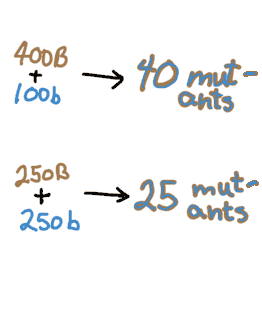"Extensive genetic studies have shown that, every generation, 10% of the brown-haired alleles mutate to the blue-haired form."
"Wow, that is like, really fast," said the assistant lamely, wishing he could come up with a good pun.
 "Yes," the Nurse shot back. "Only about a million times faster than mutations normally occur."
"Yes," the Nurse shot back. "Only about a million times faster than mutations normally occur."
"Uh, yeah. So, let's say we start with a population that has 400 brown alleles and 100 blue alleles. How many blue alleles would that be in the next generation?"
The Nurse rolled her eyes. "Well, 10% of 400 brown alleles change to blue, so that adds 40 new blue alleles to the 100 you already had."
"Grand Total 140!" interjected the Assistant.
"Yes, well, as I was saying, that leaves out reproduction."
"Good, let's leave out reproduction. We know that reproduction doesn't affect the Hardy-Weinberg equilibrium, and my head hurts already. What I'm wondering, if you started with 250 blue and 250 brown alleles, only 25 alleles would mutate instead of 40, right? So does that mean that the rate of mutation changes?"
"No it doesn't mean that the rate changes. The rate is still 10%. But the number of mutations changes -- more mutants when there's more raw material to mutate. There's a difference between the rate of mutation and the actual number mutating, you know."
"Yeah, I knew that," said the Assistant in what he hoped was a convincing tone of voice.